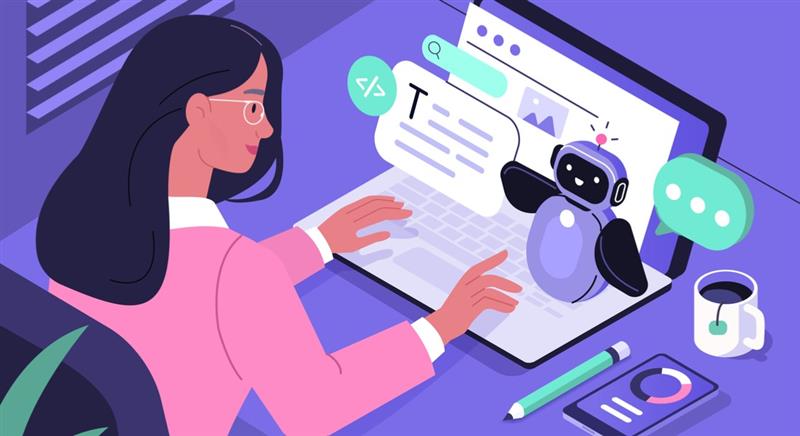AI’s Coming for L&D—Are We Too Scared to Let It In?

Even the most forward-looking professionals hesitate to learn about AI—especially when it directly affects their field. This blog, based on the insightful and comprehensive "Solved: Procrastination Guide" by Mark Manson. From emotional roadblocks to identity crises, we dissect the real reasons behind the delay and offer practical, empathy-based solutions for L&D professionals.
AI is rapidly reshaping the L&D landscape. From content automation and adaptive learning to intelligent tutoring systems and learning analytics, the tools and possibilities are expanding faster than most of us can keep up.
→ Download Now: AI in Corporate Training
And yet, many L&D professionals—even those who champion innovation in theory—remain hesitant to dive in. Courses are bookmarked but not started. AI-powered tools are explored but not implemented. Conversations about AI feel overwhelming, confusing, or even irrelevant to some.
Why the disconnect?
The issue isn’t a lack of curiosity or technical competence. It’s psychological. Drawing from Mark Manson’s brilliant "Solved: Procrastination Guide," let’s examine seven core psychological traps that make L&D professionals reluctant to embrace AI—and how we can overcome them.
1. AI Triggers Identity Threat
Learning AI forces even seasoned professionals to confront what they don’t know. For many L&D leaders who pride themselves on being experts, this is deeply unsettling.
One head of corporate training once told me, "I’ve been in this field for 25 years. I’m used to being the go-to person. But with AI, I feel like an intern."
This identity dissonance often leads to subtle avoidance. AI is positioned as "someone else's problem" or something "I'll get to when I have time."
2. We Wait for Motivation Instead of Creating Momentum
L&D professionals, ironically, fall into the same trap we help learners escape: waiting for the perfect moment to begin. We assume that once the busy quarter ends or the LMS upgrade is done, we'll find time to "explore AI."
But, as Manson highlights, action precedes motivation. That means starting small is often the only way to get unstuck. Read a case study. Attend a 15-minute webinar. Set up a sandbox trial with your team. Just do something.

3. Perfectionism Disguises Fear
Many in L&D want to get AI "right" before they start. They want to be fluent in prompt engineering, understand the data models, and know every compliance nuance before taking the first step.
This is fear, not preparation.
I remember a learning designer who spent three months researching AI content tools but never tried one. When I asked why, she said, "I want to make sure we use it ethically and effectively." Noble, yes—but also paralyzing.
We don’t need mastery to begin. We need curiosity and courage.
4. Emotions Override Logic
Let’s be honest: AI can be intimidating. It threatens existing workflows, redefines job scopes, and reminds us that change is constant. All of this triggers emotions—anxiety, self-doubt, even resentment.
I spoke with a training manager who said, "I know AI is important, but every time I open an article, I feel a knot in my stomach. What if I can't keep up?"
That reaction isn’t rare—it’s universal. The trick is to name it. And then move through it by taking action anyway.

AI in Corporate Training
Partner, Not Replacement
- AI in Corporate Training
- AI Toolkit for Super-charged Learning
- Challenges to Consider with AI Implementation
- And More!
5. Procrastination Feels Safer Than Being Exposed
If you never start learning AI, you never risk looking ignorant.
We tell ourselves we’re too busy, but underneath, it’s often the fear of being the least knowledgeable person in the room. One director admitted, "If I dive in and still don’t get it, that confirms my worst fear—that I’m obsolete."
That fear can only be disarmed by engaging. You don't have to be an AI expert. You just need to be someone willing to learn.
6. Old Habits Crowd Out New Tools
Many L&D teams still operate with tools and mindsets from the SCORM era. Their workflows revolve around slides, storyboards, and SMEs. Introducing AI—and its iterative, data-driven logic—feels like disruption.

I once introduced AI-based translation at a company where IDs feared they'd lose control. We framed it as a co-pilot, not a replacement. Adoption soared.
Start by integrating AI into existing workflows. Use AI to draft quiz questions, summarize transcripts, or generate first drafts of learning objectives. Let success breed confidence.
Discover how AI is revolutionizing corporate training by enhancing learning experiences and boosting efficiency.
7. Early Experiences Shape Current Resistance
Many professionals were raised with educational systems that punished mistakes and rewarded correctness. AI, with its trial-and-error nature, doesn’t sit well with such conditioning.
Others come from environments where experimentation wasn't safe. One learning architect told me, "In my last job, trying something new without a full ROI case was career suicide. So, I wait."
L&D professionals need spaces to experiment without risk. Pilot AI initiatives in low-stakes settings. Encourage peer learning. Celebrate small experiments. Over time, resistance softens.
Recap Table: Traps and Tactics
|
Psychological Trap |
Tactical Response |
|
Identity Threat |
Normalize being a beginner |
|
Motivation Myths |
Use small actions to trigger engagement |
|
Perfectionism |
Encourage experimentation, not mastery |
|
Emotional Avoidance |
Label the emotion and move anyway |
|
Fear of Exposure |
Create safe learning spaces |
|
Habitual Inertia |
Embed AI in existing workflows |
|
Legacy Scripts |
Pilot AI in low-risk settings |
Credit
This article was inspired by and adapted from the extraordinary "Solved: Procrastination Guide" by Mark Manson. Explore the full guide at markmanson.net.
Conclusion: Learning AI Is Emotional Work
Embracing AI in L&D isn’t just about technical capability. It’s about emotional readiness. It's about unlearning fear, reworking habits, and redefining professional identity.
We procrastinate not because we don’t care, but because we care so much that the risk feels too high. But there is no transformation without discomfort. And there is no future of L&D without AI.
If you’re stuck, start small. A 5-minute demo. A Slack thread on AI use cases. A conversation with your team about what scares them.




![How Generative AI Helps with Enhanced eLearning Design [Video]](https://blog.commlabindia.com/hubfs/blogs/How-Generative-AI-Helps-with-Enhanced-eLearning-Design-%5BInfographic%5D.jpg)
